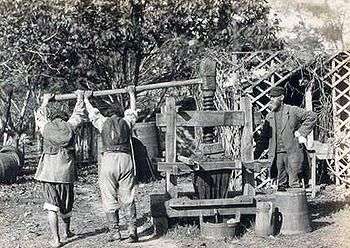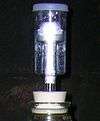Do-It-Yourself/Wine
< Do-It-Yourself
Winemaking at home
Until the early 20th century, most wine drinkers produced their own wines at home out of necessity; the average bottle of commercial wine could cost up to a month's wages for a farmer or factory hand. As can be imagined, the quality of these homemade wines was uneven and the alcohol content sometimes greater than would be expected.
In the last thirty years, however, the task of home winemaking has become easier and results more predictable. Nearly every good-sized city in North America and Western Europe has at least one shop catering to home brewers and winemakers. Kits make it possible to produce decent table wine at a fraction of the cost of the cheapest wine in the liquor store.
Making wine at home isn't necessarily easy. There's a lot of work involved, especially in cleaning and sanitizing, but the sense of accomplishment the winemaker can get from producing 30 bottles of extremely drinkable white wine for less than $2 a bottle cannot be overstated.
Required equipment


Although one could theoretically make wine with nothing more than grapes, a big barrel and some young maidens to stomp the grapes, most winemakers find the following equipment necessary to produce decent wine on a predictable basis:
- A 30-litre or larger food-grade plastic container (similar in shape to a garbage can) with a non-airtight lid and a mark at the 23-litre point
- A 23-litre glass or food-grade plastic carboy (demijhon)
- An airlock and bung (a rubber stopper with a hole in it) for the carboy
- A hydrometer to check the specific gravity (sp. gr.) of the wine
- A long, narrow tube or jar to hold the wine while you're checking its specific gravity (generally the tube the hydrometer comes in works fine)
- A dairy thermometer
- A long piece (at least 1.5m or five feet) of food-grade plastic tubing
- A long spoon that can fit into the neck of the carboy and reach to the bottom
- A wine thief to remove the developing wine from the carboy without having to tip it
It is essential that any plastic items that are in contact with the wine be made of food-grade plastic. Regular plastic will leach polymers into the wine, which will give it an odd plastic taste.
These items will last forever and most wine stores stock a reasonably priced starting kit. If you decide to brew beer as well, you can use most of this equipment, but you will need a separate 30-liter plastic container (the taste of the wine will remain in the plastic) and you should make sure your carboy is glass.
Ingredients
For every batch, you will also need the following:
- Something to ferment. Generally, that means grape juice, but wine has been made from almost all fruits, especially crabapples and elderberries. Winemaking stores sell kits containing eight to thirteen liters of concentrated grape juice varieties such as Riesling, Merlot and Chardonnay. If you are not into a specific variety, you can use unpasteurized grape juice, but it tends to be more expensive and your results might not be as predictable.
- Good quality water. Generally this means filtered water. Heavily chlorinated can skunk your wine.
- Wine yeast. The type of yeast you use will affect the flavor of the finished wine. Bread yeast can be used in a pinch (say, if you're making wine behind enemy lines during a war), but generally if you're not in dire circumstances you want to use a wine yeast tailored for the type of grape or other fruit you're using.
- Something to settle the wine. You can use sterilized bentonite, isinglass, or (in a pinch) egg whites. The first two are readily available at any winemaking store.
- Something to stop fermentation. You can use a little pure ascorbic acid (Vitamin C, but do not use vitamin pills containing sugar or flavoring), or you can buy a packet of potassium sorbate at the wine store.
- Bottles and corks. You can reuse bottles, and unless you are making champagne, it does not really matter what type of bottle you use as long as you get it clean. The best way to do this is to remove any residue in the bottles, soak them in water with strong detergent to remove the labels and the glue, wash them again in new water and detergent, rinse well, and sanitize. New bottles are also available at a reasonable price and can be reused indefinitely. You will need 30 bottles for a standard 23-liter recipe. Both natural and synthetic corks work well (although the natural is cheaper); you will need longer corks if you plan to keep the wine for longer than six months.
- Sodium metabisulfite for sanitizing. Warning — Do NOT use this under any circumstance if you or anybody in your family has a sufite allergy or sensitivity. Use iodophor or bleach instead. You must sanitize if you do not want your wine to turn out as vinegar. Sodium metabisulfite is the most convenient form of sanitizing. If you must use iodophor, follow the instructions on the label and rinse well. If you use bleach, soak your items for 10 minutes in a 5% bleach dilution, and then rinse at least six times thoroughly. Sodium metabisulfite is perfectly safe for the average person, but it can cause a serious reaction in asthmatics, so heed the warning.
- Detergent. Dish detergent is probably not strong enough. Wine stores sell strong, unscented detergents that do a better job at removing labels, old smells, etc.
Making the wine
The process of actually making the wine is simple but somewhat tedious. Kit wines must be prepared according to the manufacturer's instructions. Otherwise, the following are good rules:
- Make sure the area in which you are making your wine is at a stable temperature below 23C or 75F. At higher temperatures, the chances of your wine turning into vinegar are increased. If you can control the temperature, it is better to maintain the fermentation around 21C or 70F to preserve aromas.
- Clean and sanitize everything just before it touches the wine. That includes any funnels, cups, bowls and other items. If you have to use them on two consecutive days, clean and sanitize before every use. A good yeast will outgrow the odd bacterium that gets in, but the sloppier you are the more likely something like acetobacter is going to get in and turn your wine to vinegar.
- If your kit contains bentonite, add to your fermentation vessel about four cups or 1 liter of warm water, gently stir the water and pour the bentonite at the top of and mix well. The bentonite is used as a clarifying agent to control the protein haze.
- Pour your juice into the large high density food grade plastic container. A large glass or stainless steal container will offer better inert vessels. If you are using a concentrate, top up with filtered water to 23 liters. You want the finished product to be between 65 and 75 F or 18 to 23 C. Test with your sanitized dairy thermometer when you're up to 20 liters, and add hot or cold juice or water at the end to adjust the temperature.
- Stir vigorously to mix the concentrate properly and add oxygen to help the yeast initial growth.
- Add yeast. If the manufacturer is recommending re-hydrating first the yeast follow the manufacturer instructions. The container used will need to be cleaned, sanitized and then rinsed with clean water.
- Check your specific gravity by putting the sanitized hydrometer right in the container. It should show a specific gravity of 1.010 or greater. If it is less, you probably want to add a bit of sugar syrup and stir, then check again. Remove the hydrometer. Write down your initial specific gravity and start date. For wine kits, it is common to see a specific gravity around 1.090 (around 12.5% of potential alcohol) or more.
- Put the lid on. Cover the container with a big plastic sheet and tie it closed with some string or twine around the middle of the container.
- In a day or two, your wine should be bubbling away. Soon after that the yeast will drop to the bottom of the container and you will not see it working, but it will still be fermenting.
- After a week, clean and sanitize the carboy, the bung, the airlock and the plastic tubing. Siphon the wine into the carboy. Leave out as much of the sedimentation on the very bottom as you can. Attach the bung and the airlock, making sure to fill the airlock halfway with water.
- Cover the carboy with a dark, clean, thin sheet if you are doing this in an area where light can get to it.
- Wait ten days and check the specific gravity. The best way to do this is to use the wine thief to transfer a little wine from the carboy to the measuring tube (the one the hydrometer came in), then use the hydrometer to check the specific gravity. If you started out at 1.090, you are looking for a specific gravity of 0.998 or lower. Check this once a day until the specific gravity is the same on two separate days. A common way to determine the final alcohol level is by taking out the decimal dot and applying the following simple formula: Initial Specific Gravity minus Final Specific Gravity divided by 7.36 (i.e 1090-998/7.36=12.5%).
- Remove the bung and airlock and add whatever you are using to stop fermentation and to encourage settling. Stir for five minutes straight. Make sure to stir up all the sedimentation on the bottom. Replace the bung and the airlock.
- Fourteen days later, clean and sanitize your bottles and your tubing. Siphon the wine into the bottles and cork them. You can buy a corking machine, or you can rent or borrow one from your friendly wine store - many stores lend them free of charge to their customers. Most corks are sold pre-sanitized, but you can soak them in a sulfite solution if you cannot buy them already prepared.
- Let the bottles sit upright for three days, then let them sit on their side for at least a month. If you have made red wine, you should leave it for a year. If you do hold wine for over six months, you may wish to add a bit of sulfite to prevent discoloration, unless, of course, someone in the house has sulfite allergy or sensitivity.